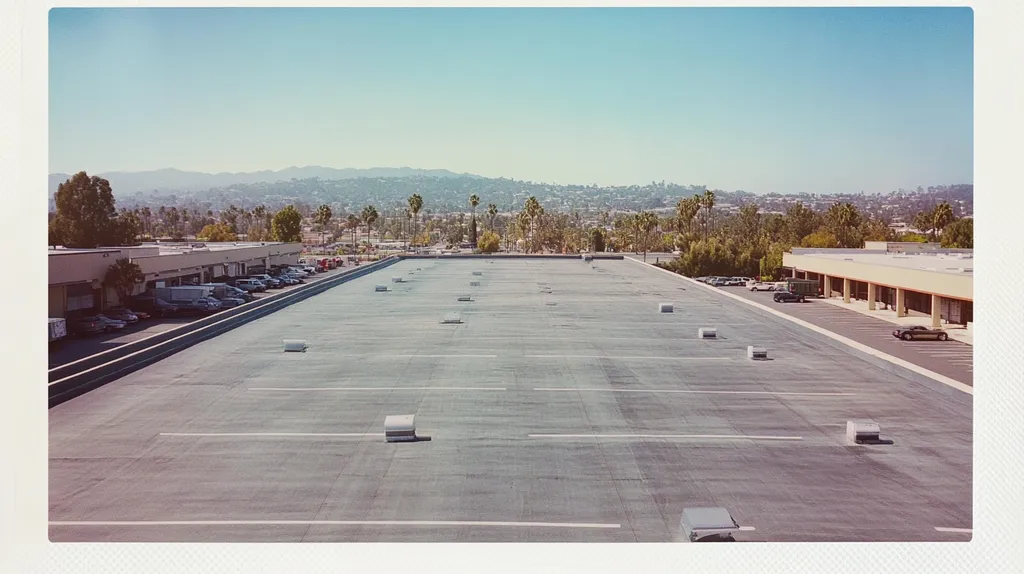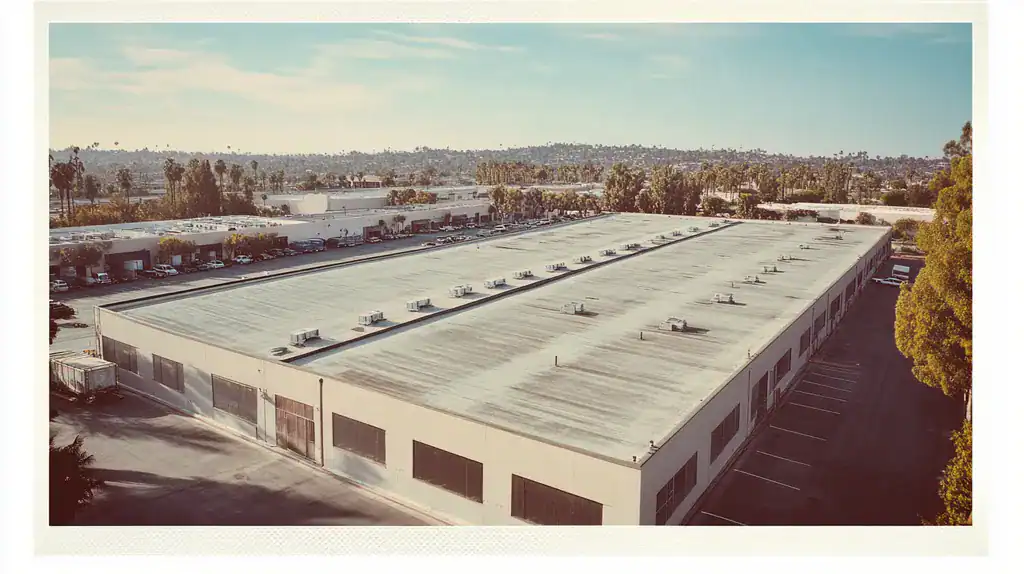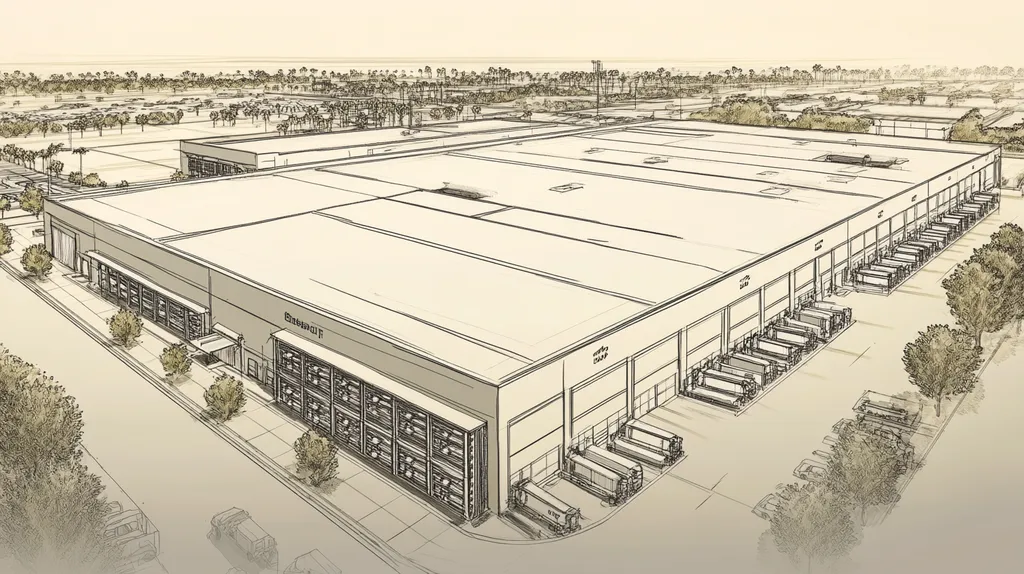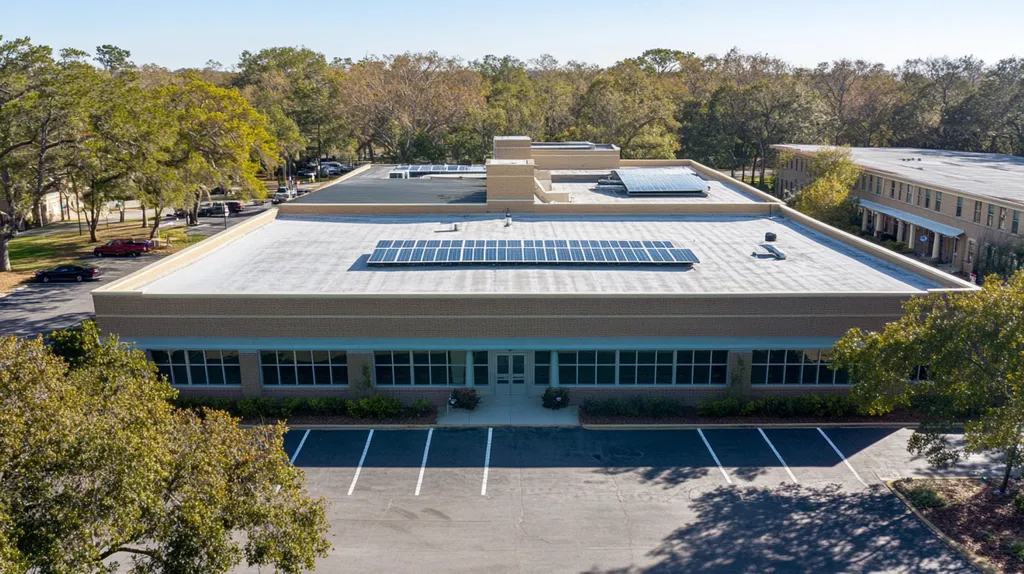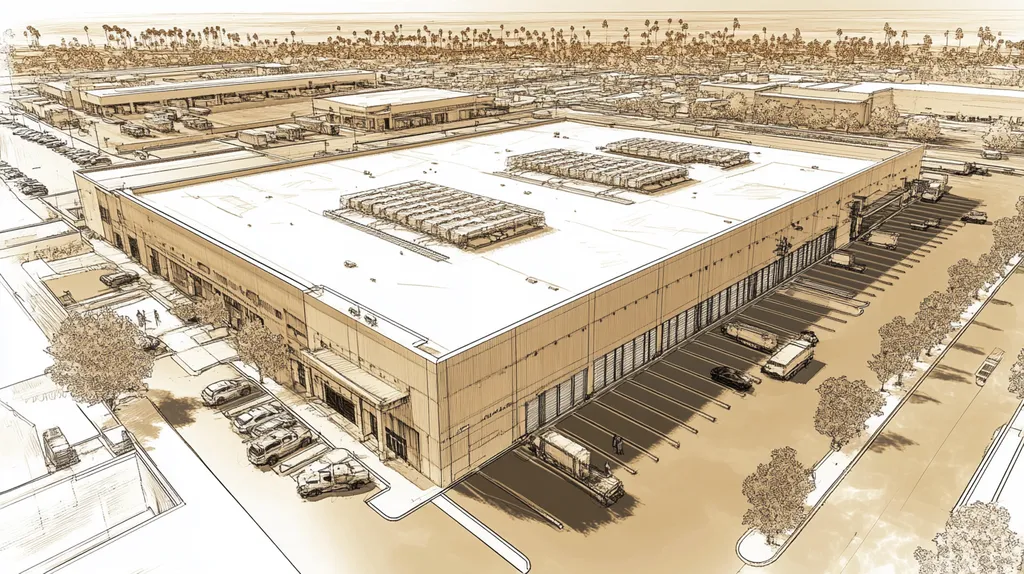Poor roofing material selection leads to over $5 billion in preventable commercial building damage annually, with 75% of premature roof failures traced directly to incompatible or suboptimal materials.
For property owners and facility managers, navigating today’s expanded range of commercial roofing options has become increasingly complex, yet critically important for building performance and longevity.
This comprehensive guide examines the essential factors in matching roofing materials to specific building types, climate conditions, and operational requirements, providing a clear framework for informed decision-making that protects your investment.
SECTION 1: THE BASICS EXPLAINED
Commercial roofing materials represent a critical investment that directly impacts building performance, operational costs, and asset value. Research shows that poor material selection leads to 75% of premature roof failures, resulting in billions in preventable repairs annually. While the variety of available materials has expanded dramatically in recent years, this has made informed selection even more crucial for long-term success.
What It Is (In Plain Language)
Commercial roofing materials encompass the complete system of components that protect buildings from environmental elements. This includes not just the visible outer layer, but also underlayment, insulation, and mechanical attachments that work together as an integrated system.
Modern commercial roofing typically falls into three main categories: single-ply membranes (TPO, PVC, EPDM), multi-ply systems (built-up roofing, modified bitumen), and metal roofing. Each category offers distinct advantages for specific building types and climate conditions.
Material composition varies significantly between options. Single-ply membranes utilize advanced polymers for flexibility and durability, while built-up systems layer multiple materials for redundant protection. Metal systems offer exceptional longevity through engineered alloys.
The quality and compatibility of these materials determine how effectively they perform their protective function over time.
Why It Matters (To Your Building)
The right roofing material directly impacts three critical areas: building protection, energy efficiency, and maintenance costs. Improper material selection can lead to premature failure, increased energy consumption, and expensive repairs that could have been avoided.
Climate considerations play a crucial role in material performance. Hot climates demand high solar reflectivity, while cold regions require materials that can handle freeze-thaw cycles. Rainfall, wind exposure, and local regulations further influence optimal material choice.
Building use patterns affect material requirements as well. Facilities with rooftop equipment need materials resistant to foot traffic and mechanical stress. Buildings with sensitive contents require materials offering superior leak protection.
The financial implications extend beyond initial installation costs. A properly selected material can reduce energy costs by 20-30% and extend roof life by 5-10 years compared to mismatched alternatives.
How It Works
Commercial roofing materials function through multiple mechanisms to protect buildings. The outer layer serves as a weather barrier, while underlying components manage moisture, provide insulation, and ensure proper attachment to the structure.
Modern materials incorporate specialized features for enhanced performance. Reflective surfaces bounce away solar radiation, while engineered polymers resist UV degradation. Seam technology creates watertight bonds that flex with building movement.
System integration is crucial for proper function. Vapor barriers, insulation layers, and drainage planes must work together to manage moisture and thermal transfer. Proper installation ensures these components perform as designed.
Material life cycles vary based on composition and exposure conditions. While some systems may last 15-20 years, others can perform effectively for 30+ years when properly specified and maintained.
SECTION 2: PRACTICAL APPLICATIONS
The selection of commercial roofing materials represents a critical decision point that directly impacts building performance and longevity. With modern roofing systems ranging from $10-30 per square foot installed, making the wrong choice can result in hundreds of thousands in unexpected costs. Understanding practical applications helps property owners and facility managers navigate these choices effectively, ensuring optimal protection and return on investment.
Common Uses & Examples
Different commercial building types demand specific roofing solutions based on their unique requirements. Retail facilities often benefit from white TPO membranes, which combine durability with superior reflectivity to reduce cooling costs in customer areas.
Manufacturing facilities typically require robust solutions like EPDM or modified bitumen that can withstand chemical exposure and frequent maintenance traffic. These materials offer excellent puncture resistance and chemical stability.
Healthcare facilities generally utilize PVC roofing due to its superior seam strength and resistance to bacterial growth. The hot-air welded seams create permanent, waterproof bonds critical for sensitive medical environments.
Cold storage facilities benefit from specialized multi-layer systems incorporating enhanced vapor barriers and increased insulation values. These systems prevent condensation issues that could compromise interior temperature control.
When You Need It Most
Material selection becomes especially critical during new construction or complete roof replacement projects. These moments represent opportunities to address existing performance issues and incorporate modern materials that enhance building efficiency.
Climate change adaptations often necessitate roofing material upgrades. Increasing storm intensity and temperature extremes require materials with enhanced wind resistance and thermal performance.
Building use changes frequently trigger the need for roofing system modifications. Converting retail space to restaurant use, for example, requires materials capable of handling increased ventilation penetrations and grease exposure.
Facility expansions present opportunities to integrate new roofing technologies with existing systems. Careful material selection ensures compatibility and maintains continuous protection across the entire structure.
Interactions With Other Systems
Roofing materials must work in concert with building envelope components to maintain proper air and moisture control. Vapor barriers, air barriers, and insulation layers require careful coordination to prevent condensation and energy loss.
Solar panel installations demand roofing materials compatible with mounting systems and capable of supporting additional loads. TPO and PVC membranes often provide ideal substrates for renewable energy implementations.
Building automation systems increasingly integrate with roofing components through sensors monitoring moisture, temperature, and structural movement. Material selection must accommodate these smart building features.
Mechanical equipment placement requires reinforced roofing materials at support points and traffic paths. Proper material specification in these areas prevents premature wear and maintains system integrity.
SECTION 3: KEY TERMINOLOGY DECODED
Clear communication can mean the difference between a successful roofing project and a costly failure. Industry studies show that terminology misunderstandings contribute to over 30% of commercial roofing disputes and delay resolution times by an average of 12 weeks. For facility managers and building owners, decoding roofing terminology isn’t just about better communication – it’s about protecting their investment and ensuring optimal performance.
Essential Terms Explained
The roofing membrane serves as your building’s primary weather barrier. This critical component keeps water out while managing thermal stress, requiring careful selection based on your specific building needs.
Thermal resistance, measured as R-value, directly impacts your building’s energy efficiency. Higher R-values indicate better insulation performance, with each point increase typically reducing heating and cooling costs by 5-7%.
Roof penetrations represent vulnerable points where pipes, vents, and equipment pass through the roofing system. Understanding these common failure points helps prevent water intrusion that can compromise building integrity.
Proper drainage design prevents ponding water that can degrade roofing materials and stress building structures. Even minor drainage issues can reduce roof life expectancy by up to 40%.
Industry Jargon Translated
TPO roofing membranes offer excellent reflectivity and flexibility while maintaining cost-effectiveness. These systems can reduce cooling costs significantly through their high solar reflectance and thermal emittance properties. (source: Renovar Roofing)
Modified bitumen systems combine traditional materials with modern polymer technology. This hybrid approach delivers exceptional durability for high-traffic areas and superior puncture resistance.
Single-ply membranes include materials like PVC and EPDM, each offering distinct advantages. Understanding these options helps match material properties to specific building requirements.
Substrate compatibility refers to how well roofing materials bond with the underlying structure. Proper material matching prevents separation issues that can compromise roof integrity.
Measurement & Units Simplified
Square footage calculations determine material quantities and costs. One roofing square equals 100 square feet, with typical commercial projects ranging from 100 to 1,000+ squares.
Slope measurements indicate how many inches the roof rises vertically for every 12 inches of horizontal distance. This ratio affects drainage performance and material selection.
Wind uplift ratings indicate a system’s resistance to air pressure forces. These ratings must match local building codes and site-specific conditions to ensure long-term performance.
Material thickness specifications vary by system type. While single-ply membranes typically range from 45 to 80 mils, built-up systems often exceed 200 mils in total thickness.
SECTION 4: DECISION FACTORS
Making informed roofing material decisions directly impacts both immediate costs and long-term building performance. Industry data shows that improper material selection leads to 40% higher maintenance costs over a roof’s lifetime and can reduce its functional lifespan by up to 50%. For commercial property owners, understanding key decision factors isn’t just about avoiding problems – it’s about maximizing return on what is often their largest building envelope investment.
Cost Considerations
Initial material costs represent only 30-40% of total roof ownership expenses over a system’s lifetime. Smart material selection must balance upfront investments against long-term maintenance, repair, and energy costs.
High-performance materials often deliver superior value despite higher initial costs. Premium materials typically reduce annual maintenance expenses by 25-35% while extending service life by 5-10 years compared to standard options.
Energy efficiency plays a crucial role in cost calculations. Reflective materials can reduce cooling costs by up to 30% in warm climates, while enhanced insulation systems cut heating expenses by 20-25% in colder regions.
Installation quality significantly impacts long-term costs. Professional installation of premium materials typically costs 15-25% more upfront but reduces repair frequency by up to 60% over the roof’s lifespan.
Performance Trade-offs
TPO roofing offers excellent reflectivity and cost-effectiveness, making it popular for commercial properties. However, it requires skilled installation to prevent seam failures and potential shrinkage issues that can compromise performance. (source: Rescue My Roof)
Wind resistance capabilities vary significantly between materials. While some systems withstand gusts up to 120 mph, others may begin to fail at much lower speeds, making careful selection crucial for exposed locations.
Chemical resistance becomes critical in industrial environments. Some materials offer superior protection against industrial emissions and chemical exposure, while others may degrade rapidly under these conditions.
Impact resistance differences affect maintenance requirements and repair frequency. Materials with higher impact ratings typically require 40-50% fewer repairs from mechanical damage and foot traffic.
Lifespan & Durability Factors
Material longevity varies dramatically based on composition and environmental exposure. While basic systems may last 15-20 years, premium materials can perform effectively for 30+ years when properly maintained.
UV resistance significantly impacts material degradation rates. Materials with advanced UV protection maintain their protective properties 30-40% longer than standard options in high-sun environments.
Thermal cycling tolerance affects long-term performance. Materials must accommodate daily and seasonal temperature fluctuations without developing cracks or separation at seams.
Moisture resistance capabilities determine system integrity over time. Advanced materials with superior moisture barriers reduce internal condensation by up to 75%, extending insulation effectiveness and preventing structural deterioration.
SECTION 5: COMMON CHALLENGES
Commercial roofing challenges directly impact building performance and operational costs. Industry data shows that 85% of premature roof failures stem from preventable maintenance issues, while improper material selection accounts for another 10%. For the average commercial building, addressing these challenges proactively can extend roof life by 7-10 years and reduce annual maintenance costs by up to 40%.
Frequent Problems & Solutions
Water intrusion represents the most common and costly roofing challenge, accounting for 70% of commercial roof damage. Poor drainage design, deteriorated flashings, and compromised seams create entry points that can damage building contents and structural elements.
Membrane punctures and tears from foot traffic, dropped tools, and equipment installation plague many commercial roofs. Installing designated walkways and equipment platforms can reduce these impacts by up to 80%.
PVC roofing systems offer excellent protection against chemical exposure and weather extremes, with proper maintenance enabling a 20+ year lifespan. Regular cleaning maintains reflectivity for optimal energy performance while allowing early problem detection. (source: Rackley Roofing)
Material degradation from UV exposure and thermal cycling leads to premature aging. Implementing protective coatings and selecting UV-resistant materials can double the effective service life of vulnerable components.
Warning Signs To Watch For
Interior water stains and dampness often indicate roof problems long before visible exterior damage appears. Regular interior inspections can identify these early warning signs before major damage occurs.
Surface blistering, splitting, and membrane shrinkage signal material stress and impending failure. These visible defects typically emerge 2-3 years before catastrophic leaks develop.
Degraded sealants and separated seams around penetrations create vulnerable points for water entry. Inspection of these high-risk areas should occur quarterly to prevent progressive damage.
Standing water remaining 48+ hours after rainfall indicates drainage problems requiring immediate attention. Every inch of standing water adds 5.2 pounds of weight per square foot to the roof structure.
Preventative Approaches
Scheduled maintenance programs reduce emergency repairs by up to 60% while extending roof life by 25%. These programs should include bi-annual professional inspections and quarterly visual assessments.
Drainage system maintenance prevents the leading cause of roof deterioration. Regular cleaning of gutters, drains, and scuppers ensures proper water removal during heavy rainfall.
Documentation of all roof activities, including repairs and modifications, helps track problem patterns. This data enables strategic planning for maintenance and eventual replacement.
Staff training on proper roof access procedures and equipment installation protocols prevents accidental damage. Even minor foot traffic damage can reduce membrane life by 15-20%.
SECTION 6: NEXT STEPS & RESOURCES
Selecting appropriate commercial roofing materials represents a critical business decision with long-lasting implications. Industry data shows that 65% of premature roof failures stem from poor material selection and installation oversight, resulting in millions in avoidable repairs annually. Understanding key questions, standards, and ongoing education opportunities helps property owners and facility managers protect their investment while optimizing building performance.
Questions To Ask Providers
Start by verifying the contractor’s experience with your specific building type and preferred materials. Request detailed case studies of similar projects completed within the last three years, including performance data and client references.
Investigate their material sourcing practices and relationships with manufacturers. Quality providers maintain direct partnerships with major manufacturers and can offer multiple material options with full warranty coverage.
Metal roofing solutions like aluminum offer exceptional durability and energy efficiency, with varying thickness options to match specific performance requirements. Standing seam, screw-down, and shingle styles provide versatile aesthetic choices while maintaining long-term value. (source: Roof Crafters)
Request detailed maintenance requirements and lifecycle cost projections for each material option. Understanding these long-term implications helps prevent unexpected expenses and premature system failure.
Industry Standards & Guidelines
Familiarize yourself with ASTM International standards for commercial roofing materials. These guidelines establish minimum performance requirements for strength, weathering resistance, and fire safety.
Review FM Global and UL requirements applicable to your region and building type. These standards affect insurance rates and warranty coverage, making compliance essential for risk management.
Consider environmental regulations and energy codes that impact material selection. Many jurisdictions now require minimum solar reflectance values and recycled content percentages for commercial roofing.
Examine local building codes regarding wind resistance, drainage requirements, and structural loading. Non-compliance can result in failed inspections and costly remediation.
Further Learning Simplified
Join professional organizations like the National Roofing Contractors Association (NRCA) for access to technical bulletins, training resources, and industry updates. Their educational materials help property owners understand evolving material technologies.
Attend manufacturer training sessions and product demonstrations. These events provide hands-on experience with different materials and installation techniques while building valuable industry connections.
Subscribe to roofing industry publications that focus on commercial applications. These resources track material innovations, pricing trends, and performance studies relevant to informed decision-making.
Participate in local building owner associations that share real-world experiences with different roofing materials. Peer insights often reveal practical considerations missing from technical specifications.
The Bottom Line
With over $5 billion in annual commercial roof damage traced to poor material selection, choosing the right roofing system has never been more critical for building performance and asset protection.
Modern commercial roofing materials offer unprecedented options for durability, energy efficiency, and environmental performance – but only when properly matched to specific building requirements and climate conditions.
Success requires careful evaluation of material properties, installation requirements, maintenance demands, and lifecycle costs against facility-specific needs.
By following industry guidelines, leveraging professional expertise, and maintaining preventive maintenance programs, property owners can expect 25-40% longer roof lifespans and up to 30% lower operational costs compared to reactive approaches.
The future of commercial roofing lies in informed material selection that balances immediate costs against long-term performance requirements.
FREQUENTLY ASKED QUESTIONS
Q. What are the basics of commercial roof materials?
A. Commercial roof materials are essential for building protection and performance. They include various components that work together, such as underlayment, insulation, and membranes. The right materials affect not just durability but also energy efficiency and maintenance costs.
Q. How do industrial roofs differ in material needs?
A. Industrial roofs require materials that withstand specific challenges, such as chemical exposure and heavy foot traffic. For manufacturing spaces, options like modified bitumen or EPDM are ideal due to their durability and resilience against harsh conditions.
Q. What key roofing terms should I understand?
A. Essential roofing terms include membrane, R-value, and roof penetrations. Understanding these terms helps ensure effective communication and can prevent costly mistakes during material selection and installation.
Q. What cost factors affect commercial roofing decisions?
A. Cost considerations include initial material prices, energy efficiency, and long-term maintenance expenses. It’s vital to balance upfront costs with potential savings over the roof’s lifetime, as high-performance materials can reduce maintenance frequency and energy bills significantly.
Q. What are some common challenges with commercial roofs?
A. Common challenges include water intrusion, membrane punctures, and material degradation from UV exposure. Proactive maintenance and prompt inspections can help mitigate these issues and extend the roof’s lifespan significantly.
Q. What next steps should I take regarding roofing materials?
A. Start by vetting your roofing contractor’s experience and asking about warranty options. Familiarize yourself with industry standards and guidelines to ensure compliance and make informed decisions that optimize performance and value.
Q. How can I enhance the longevity of my commercial roof?
A. To enhance your commercial roof’s longevity, implement regular maintenance schedules and inspections. Address drainage issues promptly and utilize UV-resistant coatings to protect against environmental damage, thus preventing premature aging of roofing materials.

